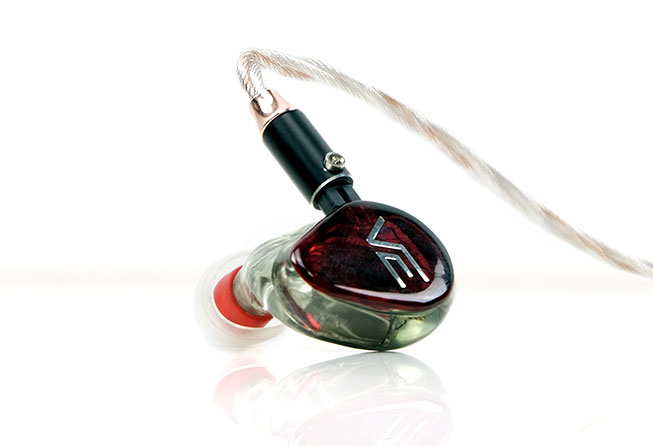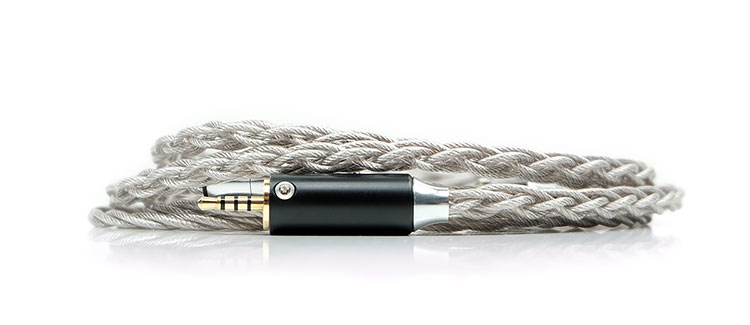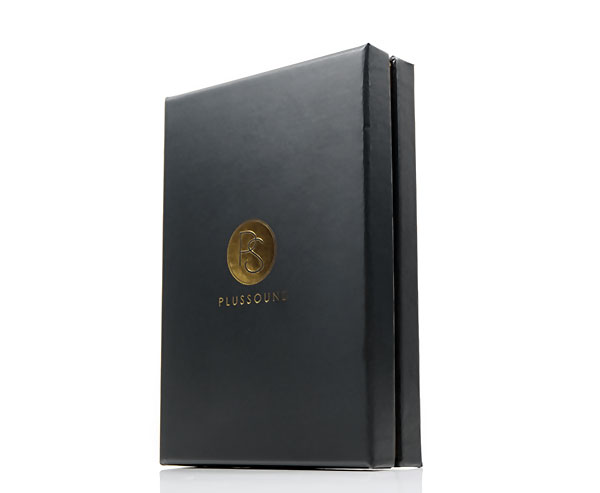Performance Impressions
(Testing was completed using a Vision Ears EVE20, 64 Audio tia Trio & U18s, MMR Gae Bolg, and Noble Audio’s flagship Sultan).
Summary
With so many elements of wiring material mixed into the Tri-Hybrid, I honestly had no clue what I was going to hear with our chosen pairings. What I got from our test monitors was a slightly more neutral tone from top to bottom but still well within what I call a natural and beautifully balanced sound signature.
If you are comparing and contrasting PLUSSOUND’s previous cables it is not as dark as the Tri-Copper nor it is as warm and rich sounding on the low-end and the mids as the Palladium-Plated Hybrid. Both of these cables are more on the euphonic side whereas the Tri-Hybrid shaves off a little bit of that girth with a little more reference-quality harmonic accuracy.
On the flip side, it is not as bright as the Tri-Silver. The Tri-Hybrid certainly ups the amount of headroom over the aforementioned competing copper and palladium hybrids but it is still smoother sounding on the upper-mids and treble on our tested monitors compared to the Tri-Silver.
I also found a similar comparative description when comparing to the palladium-plated silver and SP-OCC pure silver Athena from Satin Audio which also had a slightly more abrasive or energetic treble tone.
Because it is an X6 6-wire, you also get some fantastic levels of dynamic range and excellent resolution. Perhaps more so considering its more neutral levels of note body and what I perceived to be a strong level of separation and top-end clarity.
If you are looking for a good upgrade path from a compressed stock 4-wire OFC on a resolving monitor such as the Vision Ears EVE20 then the Tri-Hybrid is a worthy consideration.
Timbre
The Tri-Hybrid delivers a neutral to natural timbral tone compared to PLUSSOUND’s alternative hybrid cables except for the Tri-Silver which is brighter and drier across the upper mids and treble.
It does this by just taking a little weight and warmth off the low-end but still retains the same level of dynamic range and clarity as its X6 stablemates. It also has a bit more extension and energy beyond the upper mids with a stronger perceived level of headroom without tipping the timbral tone to dry or harsh sounding.
You can hear that effect the midrange performance also which has a bit more of a neutral tone in terms of weight and not quite as rounded or soft sounding with the tested monitors.
For example, the VE EVE20 with the Palladium-Plated Hybrid has a broader and richer sounding vocal texture compared to the Tri-Hybrid. However, the Tri-Hybrid creates a bit more air around the vocal so it sounds roomier in the mids with more emphasis on instrumental separation.
Staging
Again, contextually the Tri-Hybrid staging pulls back a little bit from the dense and dark tone of the Tri-Copper and the mid-range vocal intimacy of the Palladium-Plated Hybrid cables.
That means staging on the Tri-Hybrid is a bit more neutral in terms of instrumental and vocal positioning with a less aggressive low-end in terms of weight and warmth. Mids are comparatively neutral with vocals less intimacy, however, there is a degree of additional space afforded by a superior level of headroom and treble presence.
It is not as forward or as brash as the Athena or the Tri-Silver so your listening is not pulled as far up the FR of clean monitors. However, it is not as dark as the Tri-Copper and not as relaxed as the Palladium-Plated Hybrid so there is less bass and vocal emphasis.
Airy but natural with our tested IEMs and quite balanced and rounded overall in its staging quality would be an ideal short summary for the Tri-Hybrid performance.
Synergy
The Tri-Hybrid is quite a contrast to the last two cables we reviewed from PLUSSOUND, (which you can read in more detail below). It is not as rich and rounded as the Tri-Copper and Palladium-Plated Hybrids with a slightly more neutral to natural tone that should a very wide range of monitors.
I am tempted to say this should be a sound engineer’s choice of cable because it pairs ever so well with detailed monitors that are not so aggressive in the treble or bass response allowing you to reference for hours without fatigue on monitors such as the 64 Audio U18s. A balanced cable for a balanced monitor would be an apt phrase.
It stays relatively smooth but not too smooth either so sweet-sounding monitors such as the Vision Ears EVE20 sound a little more precise with less overt coloration compared to the Tri-Copper pairing and not quite as rich in the mid-bass to lower-mids as the Palladium-Plated Hybrid.
The Tri-Hybrid will also suit those who want more clarity and air on the top-end and additional instrumental separation without losing a natural tone. Monitors such as the MMR Gae Bolg and Jomo Audio’s Trinity pair really well with the Tri-Hybrid retaining a smooth tone but with enhanced dynamic range, separation, and more detectable top-end headroom and resolution.
Select Comparisons
PLUSSOUND X6 Palladium-Plated Hybrid
$1499
Technical
This was our most recent review of a PLUSSOUND cable last year and a cable that shares many similar technical and design properties with the Tri-Hybrid. Both cables are from the X6 range, both cables use a Type 6 Litz geometry and both cables utilize a hybrid 26AWG wire mix.
However, the materials used are vastly different. For a start, there is a lot more palladium stuffed inside the Palladium-Plated Hybrid, and one of the big reasons for the higher price point. You get 3 26AWG wires of palladium-plated silver and 3 26AWG wires of palladium-plated copper.
The Tri-Hybrid cuts down on the amount of palladium used to just 2 wires hence the likely lower price point. However, it massively increases the complexity of materials with its mix of tri-copper, tri-silver, and tri-metal into 3 x 2 26AWG wire groups.
Design
In keeping with the technical side, the Palladium-Plated Hybrid X6 shares a number of common design points with the newer Tri-Hybrid. Both cables use the hot-stamped metallic heat shrinks with black connectors and jack barrels and both also have a similar tight braiding build with transparent PS Insulation jackets.
The two cables also incorporate similar lightweight anodized aluminum splitter barrels finished in silvery chrome with matching adjustable chin cinch. You can of course adjust both finishes from PLUSSOUND’s long list of barrels, connectors, and jack options before you buy the cable.
Where they differ is in the aesthetics with the Tri-Hybrid offering a brighter pale copper and tan compared to the darker grey-gold tone of the Palladium-Plated Hybrid design.
The slightly brighter tone of the Tri-Hybrid just feels a slightly better match with the silvery splitter but if your want the best combo then go with a rose gold splitter to match the rose-gold of the metallic heat shrink guards.
Both cables handle in the exact same manner with superb microphonics and low levels of memory retention. Neither uses memory wire which I prefer though this sample for the Tri-Hybrid is marginally heavier due to the bigger 4.4mm plug compared to the 2.mm TRRS in the Palladium-Plated Hybrid sample.
Performance
The dynamic range between these two cables is exactly the same with our two test monitors, the tia Trio and the Vision Ears EVE20. Both showed off an excellent uptick in energy over the respective stock cables with a superior level of instrumental separation and blacker backgrounds.
However, there are some subtle differences that affect the timbre of the two monitors when switching back and forth. At first, using the tia Trio I felt the low-end impact was relatively attenuated on the tia Trio from the Tri-Hybrid. However, when comparing them on the EVE20, the Tri-Hybrid actually sounded the punchier but cleaner of the two cables.
The Palladium-Plated Hybrid produces a bass response that is softer and warmer so you tend to get a bit more mid-bass and lower-mids warmth creeping into the lower-mids instrumental timbre. I found the differences more noticeable also on the EVE20’s BA setup with the tia Trio dynamic driver voluminous output favoring the Palladium-Plated Hybrid’s richer texture.
The tonal shift in the mids follows a similar pattern with the Palladium-Plated Hybrid sounding a little sweeter, richer in note texture, and more intimate with vocal delivery. The Tri-Hybrid seems more suited to teasing out a little more air and headroom so treble is just marginally more detectable in the midrange instrumental/vocal harmonic order and treble pitched notes.
Overall, I would pick the Palladium-Plated Hybrid if you want a definite analog tone with a richer midrange and more focus on smooth intimate vocals. The Tri-hybrid is relatively more balanced and neutral suiting those who need a bit more headroom.
PLUSSOUND X6 Tri-Copper
$824.99
Technical
The Tri-Copper we have here is the EXO 4-wire version rather than the X6 variant and retails a bit cheaper also at $549. However, you can buy this as an X6 6-wire design for a price a lot closer to the Tri-Hybrid X6.
Inside, the Tri-Copper consists of three different metals in higher concentrations, UP-OCC copper, silver-plated copper, and gold-plated copper mixed into 4, 6, or 8 wires depending on your budget.
The Tri-Hybrid actually uses the Tri-Copper metal mix but only in 2 cables out of 6 in the X6 series with the other two cables using Tri-Silver and Tri-Metal which is another 6 metal elements.
Both cables are 26AWG designs and both cables also have a Litz Type 6 geometry so their structures and wire gauges are the same.
Design
What I like most about this comparison is how it shows how PLUSSOUND’s design methodology has evolved so well over the last 2-3 years. The sample we have of the Tri-Copper was from 2018 however, if you buy one today it is going to have a far closer match to the Tri-Hybrid build quality.
Now the translucent PS Insulation and tight short-throw raining on the Tri-Copper has stood the test of time so that’s quite similar on both cable designs. What is different though is the quality of the connectors and jack barrels. On the old designs it was more of a heat shrink wrap from the jack or 2-pin to the strain relief which is kind of old school and messier looking.
Now you have a higher grade of black aluminum for the jack and connector barrels with more discreet logos stamped in similar positions as well as those excellent new hot stamped metallic heat-shrink guards. All can be color coordinated also on the new designs and that includes the Tri-Copper and the Tri-Hybrid.
The splitter and chin cinch still seem to be relatively untouched with both the 2018 version and the 2021 version using the same lightweight anodized aluminum barrels just one is rose-gold and the other silver, (Tri-Hybrid).
The other key difference is really size with the EXO being a little slimmer and lighter due to it being a 4-wire as opposed to the bigger Tri-Hybrid 6-wire build. You might find the 4-wire just marginally superior for microphonics down to have a small contact area on the jacket compared to the thicker wide contact form factor of the Tri-Hybrid design.
Performance
The first thing you will notice is the dynamic range as there is a gap. The gap is not as huge as some OEM 4-wire OFC variant but going from 4-wire EXO to an X6 will bring some benefits.
With the EVE20 I felt the volume levels between these two didn’t differ so much as the superior vibrancy of the notes and swiftness of the X6 going from loud to soft. The Tri-Copper EXO just felt marginally less dynamic and a little softer in its delivery in comparison.
Of course, the metal composition also delivers a slightly different timbre and like the Palladium-Plated Hybrid, the Tri-Copper synergy with the EVE20 sounds the warmer and more rounded of the two cables. You also get a bit less air and treble presence pushing your listening focus further down to vocals and bass with the tia Trio and the EVE20.
The Tri-Hybrid just dials back a little more on the warmth sounding a bit more life-like with less richness and more accuracy. I would not classify this as bright versus warm but rather euphonic versus balanced.
It also injects a bit more separation, headroom, and better top-end resolution compared to the Tri-Copper. Instruments breathe and resolve a little bit better with the Tri-Hybrid’s roomier presentation.
Overall, the Tri-Copper is a forgiving rich, and warmer sounding cable with a euphonic vocal delivery but also paints a slightly darker sound on the test monitors. The Tri-Hybrid corrects that with an accurate harmonic balance, better dynamic range, and generally a more spacious performance.
Satin Audio Athena
$799
Technical
The final comparison is the Athena from Vietnam’s Satin Audio which comes in both 4 and 8-wire options at a very competitive price. Like the Tri-Hybrid the Athena is also a hybrid 26AWG wire though this version is 8-wire compared to the 6-wire build of the PLUSSOUND cable.
The Athena wiring consists of SP-OCC palladium-plated silver mixed with SP-OCC pure silver in a multi-size strand type 4 Litz geometry. The Tri-Hybrid uses a more complex Type 6 geometry and a vastly more exotic 9 element design grouped into 2 wires per 3 elements, Tri-Copper, Tri-Silver, and Tri-Metal.
You could argue both cables use the same materials since both have palladium-plated silver and pure silver. However, the Athena uses a much higher quantity than the Tri-Hybrid whose wider range of metals and lower wire count will produce a different type of performance.
Design
The Athena aesthetic is on the surface a brighter-looking design but that’s more down to the use of classic chrome and silver carbon fiber prints on the barrels and connectors compared to the black of the Tri-Hybrid.
On closer inspection, the wire behind the translucent jack of the Athena has a similar color consistency for some of the wires with a shade of pale copper the main differentiator on the Tri-Hybrid.
Possibly the biggest difference is the girth and braiding of the Athena. It’s a bigger cable due to the 8-wire versus 6-wire design but it is not helped by a much lower braid which I think adds to the perception of size. The braiding technique is complex on the Athena but it’s not as tight as the short throw style of the Tri-Hybrid.
The SA II insulation is also a little thicker and rubber than the PS Insulation which might be a preference issue rather than a drawback but it does create a thicker feel to Athena’s handling.
The Athena sample I have here is a 2.5mm TRSS termination so does mean a lighter jack but I find its splitter a little heavier than the Tri-Hybrid barrel. The Athena connector barrels are not quite as durable looking either.
Neither cable uses memory wire and in fairness, despite being an 8-wire, the softer insulation of the Athena mitigates the additional weight very nicely so both feel equally as comfortable on the ear. The Athena’s additional girth and weight do mean you get a slightly higher level of microphonics above the splitter compared to the Tri-Hybrid.
Performance
Kicking off with the dynamic range performance, there is a small edge to the Athena which is unsurprising given its a good quality 8-wire build but the gap between it and the 6-wire Tri-Hybrid is not huge. Both sound very resolving but maybe just a little bit more perceived additional information creeping into the top-end of the Athena.
Some of that perception is enhanced by how it affects the tuning of our tested tia Trio and EVE20 monitors. The Athena definitely pushes out a feistier top-end compared to the Tri-Hybrid.
In turn, that creates a slightly harder-edged drier instrumental note, more percussion presence, and a little bit more female vocal natural sibilance coming into focus.
The Tri-Hybrid doesn’t push the treble as hard so percussion is a little bit softer as are vocals. You find your listening focus drifting just a little further down on the Tri-Hybrid pairings whereas the Athena pairing’s upper mids presence keeps the ear further up.
On the low-end, the Tri-Hybrid pairing produced a slightly weightier warm response and a bit more bloom coming into the lower mids. The Athena was plenty impactful with the same monitors but the quantity was a little more neutral and the harmonic balance slightly cooler.
Overall, the Athena is the stronger of the two cables for top-end energy being slightly drier and brighter. Whereas the Tri-Hybrid is a little smoother, less treble focus, and a bit more weight on the low-end.
Our Verdict
The Tri-Hybrid is one of the most balanced sounding cables I have heard to date from PLUSSOUND. It has less overt coloration than the Palladium-Plated Hybrid or the Tri-Copper and slightly smoother on the top-end compared to the Tri-Silver.
The dynamic range is as excellent as ever but rather than something close and intimate it’s a little more neutral in its staging performance. It is an excellent pairing for detail-orientated monitors and will do little to upset their core tonal balance.
Considering the huge number of different metals inside the Tri-Hybrid it is testimony to the company that they have managed to fuse them all together and produce such a beautiful-looking cable with a controlled yet smooth-sounding performance.
PLUSSOUND Tri-Hybrid Specifications
- Gauge: 26AWG
- Core Count: 6 (comes in 4 and 8 also)
- Geometry: Type 6 Litz
- PS Insulation
- Proprietary dampening core
- Anodized aluminum splitter & Chin cinch
- Length: 1.2m (longer upon request)






